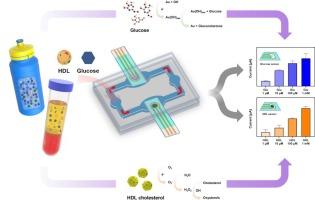Non-enzymatic multiplexed detection of glucose and high-density lipoprotein cholesterol using the nanocomposites-based electrochemical microfluidic platform
IF 4.9
2区 化学
Q1 CHEMISTRY, ANALYTICAL
引用次数: 0
Abstract
Metabolic syndrome is a group of conditions that together raise the risk of various diseases such as diabetes, stroke, cardiovascular diseases, and other serious health disorders. Herein, we developed a non-enzymatic electrochemical sensor platform for the simultaneous detection of glucose and high-density lipoprotein cholesterol which are known as metabolic syndrome biomarkers. We fabricated two sensing layers using nanocomposites comprising multi-walled carbon nanotubes and nanoparticles (e.g., gold titanium dioxide and zinc oxide) for non-enzymatic detection. At the glucose sensing part, the linear detection range was from 1 nM to 100 mM and the limit of detection was 1 nM. Meanwhile, the linear detection range was from 1 nM to 100 μM and the limit of detection was 1 nM at the high-density lipoprotein cholesterol sensing layer. Additionally, the non-enzymatic electrochemical sensor platform could selectively detect glucose and high-density lipoprotein cholesterol, and the detection capability of the sensor was maintained for 3 weeks. Moreover, we demonstrated sensitive and selective detection of spiked glucose and high-density lipoprotein cholesterol in human plasma and ion sports drinks.

基于纳米复合材料的电化学微流控平台对葡萄糖和高密度脂蛋白胆固醇的非酶复用检测
代谢综合征是一组病症,它们共同增加了患各种疾病的风险,如糖尿病、中风、心血管疾病和其他严重的健康失调。在此,我们开发了一个非酶电化学传感器平台,用于同时检测葡萄糖和高密度脂蛋白胆固醇,这被称为代谢综合征的生物标志物。我们使用由多壁碳纳米管和纳米颗粒(如金、二氧化钛和氧化锌)组成的纳米复合材料制作了两个传感层,用于非酶检测。葡萄糖传感部分,线性检测范围为1 nM ~ 100 mM,检出限为1 nM。同时,在高密度脂蛋白胆固醇传感层的线性检测范围为1 nM ~ 100 μM,检测限为1 nM。此外,非酶电化学传感器平台可以选择性检测葡萄糖和高密度脂蛋白胆固醇,传感器的检测能力维持3周。此外,我们证明了对人血浆和离子运动饮料中添加的葡萄糖和高密度脂蛋白胆固醇的敏感和选择性检测。
本文章由计算机程序翻译,如有差异,请以英文原文为准。
求助全文
约1分钟内获得全文
求助全文
来源期刊

Microchemical Journal
化学-分析化学
CiteScore
8.70
自引率
8.30%
发文量
1131
审稿时长
1.9 months
期刊介绍:
The Microchemical Journal is a peer reviewed journal devoted to all aspects and phases of analytical chemistry and chemical analysis. The Microchemical Journal publishes articles which are at the forefront of modern analytical chemistry and cover innovations in the techniques to the finest possible limits. This includes fundamental aspects, instrumentation, new developments, innovative and novel methods and applications including environmental and clinical field.
Traditional classical analytical methods such as spectrophotometry and titrimetry as well as established instrumentation methods such as flame and graphite furnace atomic absorption spectrometry, gas chromatography, and modified glassy or carbon electrode electrochemical methods will be considered, provided they show significant improvements and novelty compared to the established methods.
 求助内容:
求助内容: 应助结果提醒方式:
应助结果提醒方式:


